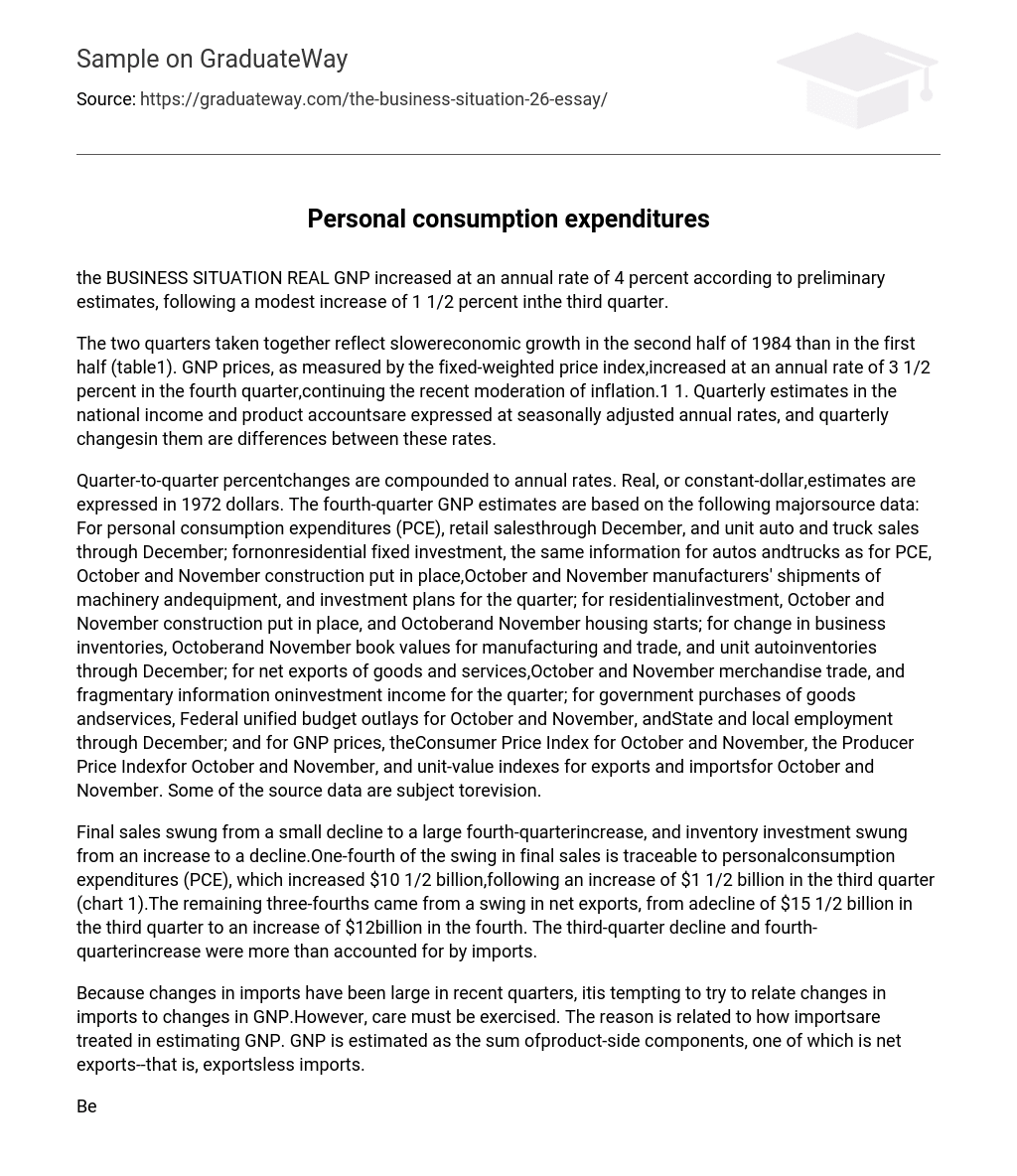Iincreased at an annual rate of 4 percent according to preliminary estimates, following a modest increase of 1 1/2 percent inthe third quarter. The two quarters taken together reflect slowereconomic growth in the second half of 1984 than in the first half (table1). GNP prices, as measured by the fixed-weighted price index,increased at an annual rate of 3 1/2 percent in the fourth quarter,continuing the recent moderation of inflation.
Quarterly estimates in the national income and product accountsare expressed at seasonally adjusted annual rates, and quarterly changesin them are differences between these rates. Quarter-to-quarter percentchanges are compounded to annual rates. Real, or constant-dollar,estimates are expressed in 1972 dollars. The fourth-quarter GNP estimates are based on the following majorsource data:
- For personal consumption expenditures (PCE), retail salesthrough December, and unit auto and truck sales through December;
- fornonresidential fixed investment, the same information for autos andtrucks as for PCE, October and November construction put in place,October and November manufacturers’ shipments of machinery andequipment, and investment plans for the quarter;
- for residentialinvestment, October and November construction put in place, and Octoberand November housing starts;
- for change in business inventories, Octoberand November book values for manufacturing and trade, and unit autoinventories through December;
- for net exports of goods and services,October and November merchandise trade, and fragmentary information oninvestment income for the quarter;
- for government purchases of goods andservices, Federal unified budget outlays for October and November, andState and local employment through December;
- for GNP prices, theConsumer Price Index for October and November, the Producer Price Indexfor October and November, and unit-value indexes for exports and importsfor October and November. Some of the source data are subject torevision.
Final sales swung from a small decline to a large fourth-quarterincrease, and inventory investment swung from an increase to a decline.One-fourth of the swing in final sales is traceable to personalconsumption expenditures (PCE), which increased $10 1/2 billion,following an increase of $1 1/2 billion in the third quarter .
The remaining three-fourths came from a swing in net exports, from adecline of $15 1/2 billion in the third quarter to an increase of $12billion in the fourth. The third-quarter decline and fourth-quarterincrease were more than accounted for by imports. Because changes in imports have been large in recent quarters, itis tempting to try to relate changes in imports to changes in GNP.However, care must be exercised. The reason is related to how importsare treated in estimating GNP. GNP is estimated as the sum ofproduct-side components, one of which is net exports–that is, exportsless imports.
Because the other components include expenditures onforeign-produced goods and services (as well as on U.S.-produced goodsand services), imports must be subtracted to get GNP, a measure of U.S. production. Therefore, an increase (decrease) in imports has no effecton GNP because it is offset by increases (decreases) in expenditures onforeign products included in other product-side components.Accordingly, it would be a mistake to subtract–as might appeartempting–the change in imports from the change in GNP with the intentof deriving a useful analytical measure. What has just been said about GNP–that an increase (decrease) inimports has no effect–applies also to final sales of GNP.
All importsare treated as going into final sales, rather than being split betweenfinal sales and the change in business inventories; data are notavailable to make the split. Thus, final sales of GNP as a measure ofworldwide final sales of U.S. production is likely to be misstatedbecause some imports, such as consumer goods and industrial supplies, gointo inventory in the period in which they are brought into thiscountry.
That some imports go into inventory is consistent with thepositive correlation of changes in inventory investment and changes inimports, especially in recent quarters: Inventory investment and importsincreased sharply in the third quarter, and both declined sharply in thefourth. A further result of this treatment of imports is thatinventory-sales relationships as measured by the ratio of total businessinventories to total final sales is overstated to the extent thatimports go into inventories. In that ratio, all imports have beenremoved from the denominator. One measure that may help answer some of the questions being askedabout the impact of imports, and also exports, is final sales todomestic purchasers.
This measure can be viewed in two ways: either asfinal sales of GNP less exports plus imports, or as the sum of personalconsumption expenditures, gross private domestic fixed investment, andgovernment purchases. It represents final demand in theUnited States for goods and services, wherever produced. In the fourthquarter, real final sales to domestic purchasers increased 5 percent,indicating that final demand in the United States was weaker than realfinal sales of GNP, which increased 8 1/2 percent. In the thirdquarter, final sales in the United States increased 3 percent and finalsales of GNP declined 1 percent.
The twoquarters’ performance was weaker than earlier in this recovery andexpansion, when both real product and hours had increased strongly. Unit labor cost increased 1 1/2 percent in the fourth quarter–muchless than the 5-percent rate registered in the third. Low rates ofincrease in unit labor cost have contributed substantially to themoderation in prices in recent quarters.





